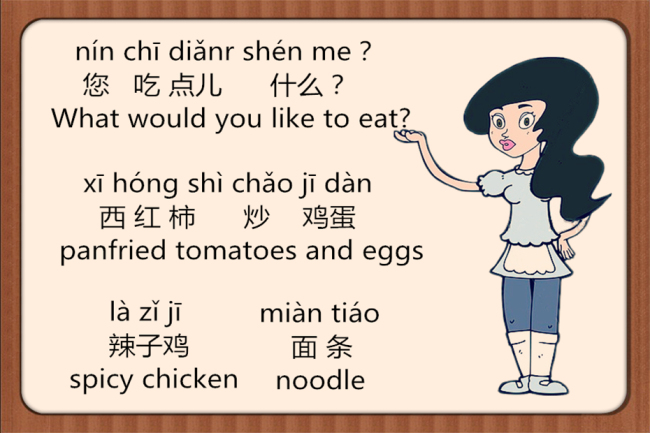Lesson 080 Revision of Expressions Used in Restaurant 第八十课 餐厅复习课

YJ: Dajia hao. Welcome to Chinese Studio.
Cam: dajia hao. During the week Yajie has recommended a variety of delicious Chinese foods. Now let’s go and have a brief review.
******************
Sentences in the week
Welcome. 欢迎光临(huan1ying2 guang1lin2)。Please be seated. 请坐(qing3 zuo4)。What would you like to eat? 您吃点儿什么(nin2 chi1 dianr3 shenme2)?Spicy Chicken 辣子鸡(la4zi ji1);spareribs in sweet and sour sauce糖醋排骨(tang2cu4 pai2gu3). panfried tomatoes and eggs 西红柿炒鸡蛋 (xi1hong2shi4 chao3 ji1dan4);Rice, 米饭(mi3fan4); noodle 面条(mian4tiao2)。All in today’s Chinese Studio.
******************
YJ: When you walk into a Chinese restaurant, first you may hear欢迎光临(huan1ying2 guang1lin2), Welcome.
Cam: Yes, 欢迎光临(huan1ying2 guang1lin2), welcome.
YJ: 欢迎, the first tone, and the second tone.
Cam: 欢迎, that means welcome. Right?
YJ: yes. And 光临shows the respect for the customers.
Cam: 光临 (guang1lin2).
YJ: 欢迎光临(huan1ying2 guang1lin2), Welcome.
Cam: 欢迎光临(huan1ying2 guang1lin2).
YJ: And then the waiter or waitress will say请坐(qing3 zuo4)。Please be seated.
Cam: 请(qing3) means please. And 坐(zuo4) is to sit down., the fourth tone. 请坐(qing3 zuo4).
Conversation1:
YJ: Now it’s time to order something. 您吃点儿什么(nin2 chi1 dianr3 shenme2)?What would you like to eat?
Cam: 您吃点儿什么(nin2 chi1 dianr3 shenme2)?
YJ: 吃, c-h-i, the first tone, to eat.
Cam: 吃(chi1).
YJ: 吃点儿(chi1 dianr3), to eat a little bit. Here点儿( dianr3) is short for 一点儿 ( yì dianr3), which means a little bit. 吃点儿(chi1 dianr3).
Cam: 吃点儿(chi1 dianr3).
YJ: 您吃点儿什么(nin2 chi1 dianr3 shenme2)?
Cam: 您吃点儿什么(nin2 chi1 dianr3 shenme2)?
YJ: I’d like to recommend some Sichuan and Shanghai specialties. The first one is辣子鸡(la4zi ji1). Spicy chicken.
Cam: 辣子鸡(la4zi ji1)
YJ: As you know, Sichuan food is characterized by hot, pungent, and salty flavors. 辣子(la4zi) is the informal name of pepper. 辣子(la4zi)
Cam: 辣子(la4zi), pepper. And 鸡(ji1) means chicken. Right?
YJ: Yes. 鸡(ji1), ji the first tone. Chicken. 辣子鸡(la4zi ji1), spicy chicken.
Cam: 辣子鸡(la4zi ji1).
YJ: Also if you are fond of sweet food, you must try spareribs in sweet-and-sour sauce. In Chinese it’s糖醋排骨(tang2cu4 pai2gu3).
Cam: 糖醋排骨(tang2cu4 pai2gu3).
YJ: 糖(tang2), tang, the third tone, means sugar.
Cam: 糖(tang2). I know that Shanghai is famous for its sweet taste.
YJ: Right. 醋(cu4), cu, the fourth tone, means vinegar.
Cam: 醋(cu4).
YJ: 排骨 means spareribs. 排,the second tone, and 骨,the third tone.
Cam: 排骨 (pai2 gu3).
YJ: 糖醋排骨(tang2cu4 pai2gu3), spareribs in sweet and sour sauce.
Cam: 糖醋排骨(tang2cu4 pai2gu3).
Conversation 2:
YJ: Now I think we need to order a vegetable dish and some main courses.
Cam: Yes. How about panfried tomatoes and eggs, that would be 西红柿炒鸡蛋 (xi1hong2shi4 chao3 ji1dan4)?
YJ: Sounds good to me. 西红柿(xi1hong2shi4)means tomato, we learned this word before.
Cam: 西红柿(xi1hong2shi4).
YJ: And鸡蛋 (ji1dan4) means egg.
Cam: 鸡蛋 (ji1dan4).
YJ: 炒(chao3) means stir-fry or pan fry.
Cam: 炒(chao3), c-h-a-o, that's the third tone, right?
YJ: Exactly. Together it’s 西红柿炒鸡蛋 (xi1hong2shi4 chao3 ji1dan4)
Cam: 西红柿炒鸡蛋 (xi1hong2shi4 chao3 ji1dan4).Yajie, what main courses do they have in here?
YJ: They have米饭(mi3fan4), rice and 面条(mian4tiao2), noodles.
Cam: 米饭(mi3fan4) and 面条(mian4tiao2),
Conversation 3:
YJ: That’s it for this week’s Chinese Studio. Now comes the question of the week: what’s Chinese for “spareribs in sweet and sour sauce”?
Cam: Have a fantastic weekend. 周末愉快! (zhou1mo4 yu2kuai4)
YJ: 周末愉快! (zhou1mo4 yu2kuai4)

